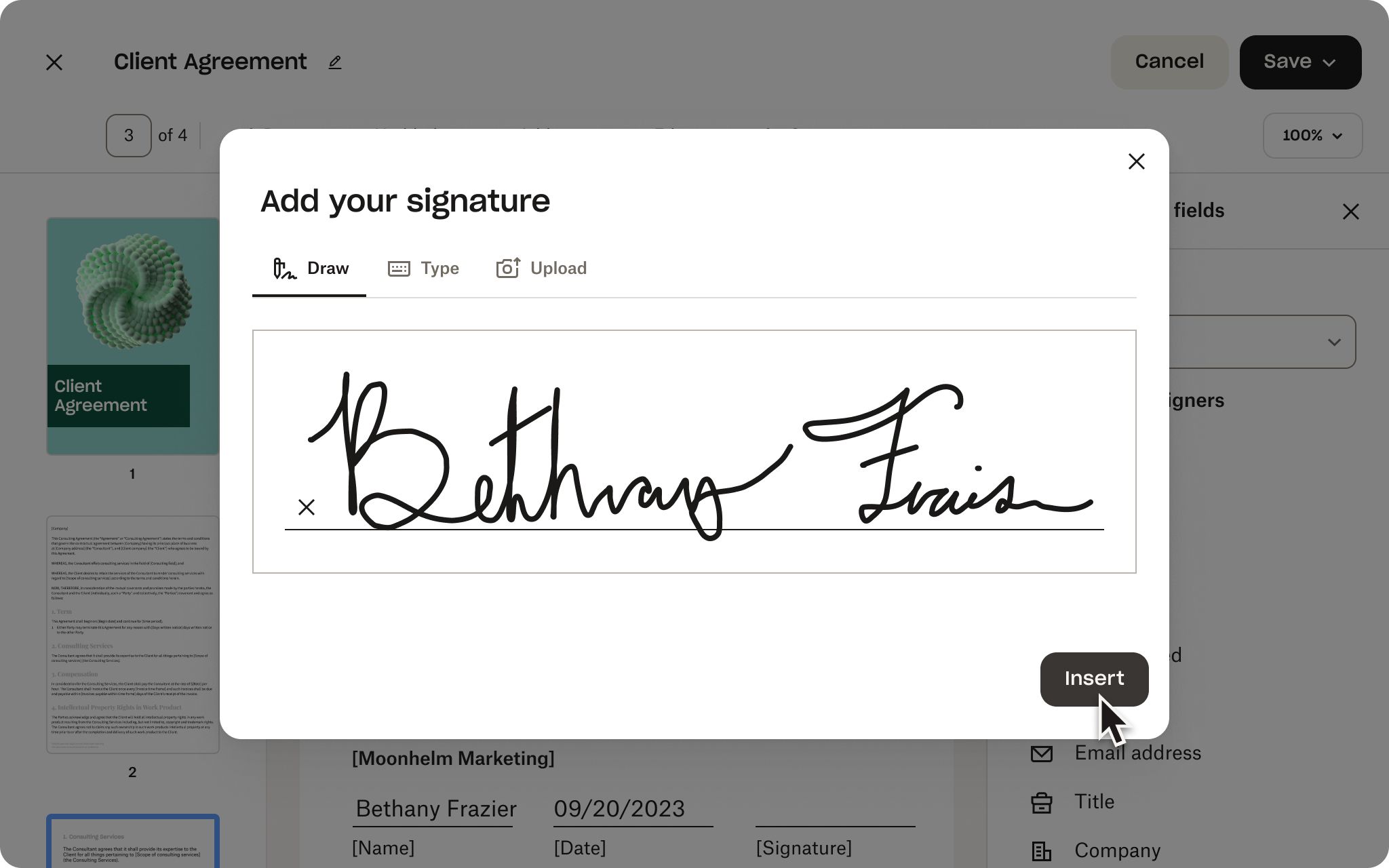I modsætning til salgssupport, som fokuserer på at levere ressourcer og værktøjer til salgsteams, eller skabelse af engagement hos potentielle kunder, som dækker den bredere strategi for relationsopbygning, forbedrer salgsengagementet de daglige interaktioner, der vedligeholder forbindelsen til kundeemnerne og fremmer deres købsbeslutning.
Her gennemgår vi processen for salgsengagement og deler, hvordan du kan bruge værktøjer som Dropbox til at forbedre din strategi og skabe bedre resultater.
Brug af værktøjer til forbedring af processen for salgsengagement
Styring af processen for salgsengagement forvandler dine kundeemner til loyale kunder på en effektiv måde. Derudover kan integration af de rigtige værktøjer i hvert trin optimere din arbejdsgang, hjælpe dig med at personliggøre interaktioner og øge salget.
Sådan kan du forbedre dit salgsengagement med værktøjer:
Kvalifikation af kundeemner
Du kan starte med at forbedre din kvalifikation af kundeemner. At finjustere dine kundeemner og fokusere på dem med det største konverteringspotentiale er afgørende for at opnå en effektiv kvalifikation af kundeemner.
Værktøjer med CRM-integrationer (Customer Relationship Management) kan hjælpe dig med dette. De kan hjælpe med at bedømme og rangordne kundeemner på en effektiv måde, så du kan prioritere kundeemner med "lav", "middel" eller "høj" interesse.
Dropbox har eksempelvis et udvalg af integrationer til marketing- og salgsværktøjer, herunder CRM-værktøjer som Zoho CRM, OnePageCRM og amoCRM.
Fordele ved at bruge CRM-integrationer
Centraliseret dataadgang: Opbevar alle dine kundeemner ét sted for hurtige og informerede beslutninger. Dette er fantastisk til større og mere distribuerede teams.
Automatiseret lead scoring: Mange CRM-værktøjer sorterer og rangerer automatisk leads baseret på deres potentiale, hvilket sparer betydelig tid og kræfter.
Forbedret datanøjagtighed: CRM-værktøjer kan holde dine leaddata nøjagtige og opdaterede via datasynkronisering på tværs af flere leadlister eller databaser.
Outreach
Det næste trin i processen er at udforme personlige beskeder, der taler direkte til hver enkelt potentiel klients behov og problemstillinger, og værktøjer kan hjælpe med at styre processen.
Værktøjer til e-mailautomatisering er meget nyttige i denne forbindelse, fordi de giver dig mulighed for at skalere denne vigtige del af salgsengagementet, så du opnår en rettidig og tilpasset kontakt uden for meget manuelt arbejde. Det er et vigtigt trin, som værktøjer kan hjælpe med på en meget effektiv måde.
Fordele ved værktøjer til e-mailautomatisering
Effektivitet i stor skala: Automatisering af e-mails betyder, at du kan nå ud til et bredere publikum uden at miste det personlige præg. Dette er fantastisk til opsøgende arbejde på tværs af en enorm liste eller database.
Handlingsbaseret automatisering: Konfiguration af din e-mailmarketingplatform til at udløse opfølgende e-mails baseret på leadhandlinger holder dem engagerede på de rigtige tidspunkter og fører dem blidt gennem processen uden manuel input.
Segmentering: Det er muligt at bruge automatiserede e-mailmarketingværktøjer til at målrette specifikke grupper inden for dine leads med skræddersyet budskab, f.eks. dem med interesse i et specifikt produkt, hvilket forbedrer relevans og svarprocenter.
Engagement
Typisk vil du engagere dine potentielle kunder på tværs af flere kanaler på dette trin – uanset om det er via e-mail, telefonopkald, sociale medier eller en kombination. Dette hjælper med at øge dine kontaktpunkter og sikre, at potentielle klienter og kunder husker dig.
Multikanalværktøjer til salgsengagement er fantastiske her, da de giver en problemfri kommunikationsoplevelse i engagementet, sikrer at dit budskab er ensartet og effektivt – og gør også denne del af processen meget nemmere for dig.
Fordele ved værktøjer på flere kanaler
Strømlinet kommunikation: Med værktøjer til engagement via flere kanaler kan du administrere alle interaktioner fra én platform, hvilket reducerer kompleksiteten af opsøgende arbejde via flere kanaler.
Omnichannel-engagement: Engager dine leads, uanset hvor de er, og øg dine chancer for konvertering.
Forbedret dataindsamling og -analyse: Disse værktøjer hjælper dig med at indsamle værdifuld indsigt fra hver interaktion, hvilket hjælper dig med at finpudse din strategi senere.
Indholdsdeling og demoer
At tilbyde værdifuldt salgsindhold og gennemføre virtuelle demoer er en god måde at vise dit produkts fordele under salgsengagementsprocessen. Du kan enkelt bruge værktøjer til skærmoptagelse til at oprette og sende en skærmoptagelse ved hjælp af et par klik.
Mens du gør dette, er engagementssporingsværktøjer som Dropbox DocSend ideelle til at få indsigt i, hvordan disse potentielle kunder interagerer med dit indhold, så du kan skræddersy opfølgninger baseret på deres interesse.
Fordele ved Send og spor-værktøjer
Problemfri deling: Send og spor, så du nemt kan distribuere indhold til potentielle kunder uden at bekymre dig om filstørrelser eller leveringsproblemer
Kontrolleret adgang: Del følsomme dokumenter sikkert, og spor, hvem der tilgår dem, så dine data holdes sikre, mens du interagerer med kundeemner.
Organisering og prioritering af kundeemner: Brug engagementsdata til at prioritere opfølgninger med de mest interesserede kundeemner
Opfølgning
En vigtig del af en effektiv salgsengagementsproces er implementering af en struktureret opfølgningsproces, der hjælper med at opretholde forbindelsen til kundeemner og fastholde deres opmærksomhed.
Brug af CRM-systemer med automatiserede opfølgningspåmindelser og planlægning sikrer, at du aldrig går glip af et kritisk kontaktpunkt.
Implementer en struktureret opfølgningsproces for at holde potentielle kundeemner i fokus. Kig efter CRM-systemer med funktioner som automatiserede opfølgningspåmindelser og planlægning.
Fordele ved CRM-værktøjer til opfølgning
Automatiske påmindelser: Opret påmindelser til opfølgninger, hvilket sikrer ensartet kommunikation uden manuel sporing
Opgavestyring: Du kan ofte administrere dine to-do-lister direkte i dit CRM-værktøj og dermed holde din opfølgningsproces organiseret.
Lead nurturing: CRM kan give nyttige indsigter til at pleje leads med relevant indhold og rettidig opfølgning, hvilket øger dine chancer for at lukke handlen

Afsluttende faser
En potentiel kunde siger "ja", men salgsengagementet stopper ikke her! Effektive afslutningsteknikker kan pleje relationen og sikre en ubesværet overgang fra kundeemne til tilbagevendende kunde.
Det er her, at værktøjer med integrerede e-signaturer, som f.eks.Dropbox Sign, kan hjælpe med at sende og dele vigtige dokumenter fra salgsprocessen.
Fordele ved e-signatur og værktøjer til dokumentdeling
Effektivitet og sikkerhed: Du kan lukke handler hurtigere ved at tilføje juridisk bindende e-signaturer, hvilket sikrer, at alle parter er beskyttet.
Brugervenlighed: E-signaturer gør det nemt for kunder at underskrive og returnere dokumenter, hvilket reducerer friktion i afslutningsprocessen.
Dokumentsporing: Det er nemt at holde styr på dokumentstatus i realtid med e-signaturer, så du ved præcis, hvornår en aftale er afsluttet.
Samlet set er værktøjer meget nyttige til at hjælpe med de ressourcekrævende eller irriterende opgaver – så du kan fokusere på at pleje dine leads. Du kan også forfine salgsprocessen over tid og justere den afhængigt af, hvad du sælger, og hvem du sælger til.

Hvorfor investere i dedikeret software til salgsengagement?
Du kunne gøre det hele manuelt – men teknologi kan give dig et reelt boost. Salgsengagementsværktøjer eliminerer gætteri og tilbyder en række funktioner, der ikke kun optimerer din arbejdsgang, men også forbedrer din evne til at komme i kontakt med potentielle kunder.
Investering i professionel software til salgsengagement giver dig flere fordele:
Højere effektivitet
Software til salgsengagement automatiserer repetitive opgaver, reducerer mængden af manuelt arbejde og effektiviserer dine processer, så teams kan fokusere på det, der er vigtigt – at lukke handlen.
Handlingsbaserede, datadrevne indsigter
Med værktøjer til salgsengagement kan du få værdifuld indsigt i, hvordan potentielle kunder interagerer med dit indhold.
For eksempel giver DocSend dig feedback i realtid, så du kan se, hvad der fanger interessen – og hvad der ikke gør – så du kan finjustere din fremtidige strategi.
Enklere teamintegration
Samlet kommunikation, opdateringer i realtid og delt analyse sikrer, at dit salgsteam altid har adgang til den samme viden. Den ubesværede integration blandt dine teammedlemmer kan desuden resultere i en mere velinformeret, forbunden og agil salgsorganisation.
Bedre samarbejde
Platforme til salgsengagement gør samarbejde til en leg. Teammedlemmer kan tildele opgaver eller monitorere fremskridt, og ledere kan træde til, når der er behov for det – alt sammen fra ét centralt sted. Det svarer til en virtuel salgsassistent, der er 100 % nøjagtig, for alle personer i dit team.
Pålidelig skalerbarhed
Dine behov vokser i takt med din virksomhed. Dedikerede værktøjer til salgsengagement kan skaleres efter dine behov, så du får en fleksibel løsning, der udvikler sig i takt med dine salgsstrategier.
Ved at bruge Dropbox forbedrer du dine salgsinteraktioner og sætter dit team op til langsigtet succes. Det er en alt-i-én-løsning med funktioner, der øger salgsengagementet – og mange andre vigtige arbejdsgange.

Brug af Dropbox til en ubesværet oplevelse under salgsengagement
Salgsengagement er afgørende, og de rette værktøjer er vigtige for, at både salgsmedarbejdere og kunder får en positiv oplevelse.
Dropbox optimerer salgsengagementet med e-signaturer, appintegrationer og mere – frigør dit potentiale med en samlet løsning, der sikrer teams gode resultater.
Ofte stillede spørgsmål om salgsengagement
Måling af effektivitet kræver sporing af de rigtige målinger. Dette er forskelligt fra situation til situation, men værktøjer til salgsengagement kan give indsigt i ting som åbningsrater, klikrater og svartider.
Ved hjælp af en analyse af resultatet af engagementsteknikker – som f.eks. hvilke e-mails, der opnår den højeste svarprocent, eller hvilke opfølgningsstrategier der fører til flest konverteringer – kan du tilpasse og effektivisere din fremgangsmåde. Monitorering og gennemgang af disse parametre giver overblik over, hvor godt din samlede salgsengagementsproces forløber.
Fejl omfatter manglende opfølgning på leads konsekvent, manglende opsætning af værktøjer til at minde dig om vigtige opfølgninger og deadlines samt manglende personlig kommunikation.
Brug af salgsengagementsværktøjer til at segmentere kundeemner og skræddersy budskaber til deres specifikke behov kan hjælpe med at undgå disse problemer. En anden fejl er at ignorere feedback – indsigt fra kundeinteraktioner kan hjælpe dig med løbende at forfine din tilgang.
Automatisering optimerer salgsengagementsprocessen. Den hjælper dig med at sende rettidige og ensartede opfølgninger, så du aldrig går glip af muligheder.
For eksempel kan automatiserede opfølgningsmails eller påmindelser, efter at et lead viser interesse, hjælpe dig med at bevare kontrollen uden manuelt at skulle spore interaktioner. Automatisering tager sig også af rutineopgaver og frigør din tid til at fokusere på at opbygge relationer og lukke handler med dine kundeemner.


